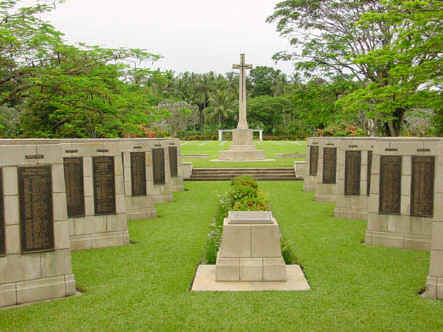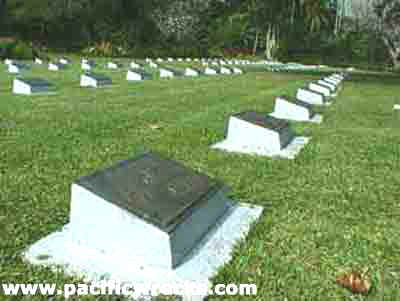Rabaul lies on Blanche Bay
inside the hook-nosed north-eastern tip of the Gazelle Peninsula of New
Britain, the largest and most important island of the Bismarck
Archipelago. The Memorial is situated in Rabaul (Bita Paka) War
Cemetery, which is located approximately 50 kilometres south of Rabaul,
and approximately 5 kilometres south-west of Kokopo.
 |
The Rabaul Memorial commemorates over
1,200 members of the Australian Army (including personnel of the New
Guinea and Papuan local forces and constabulary) and the Royal
Australian Air Force, who lost their lives in New Britain and New
Ireland in January and February 1942, and in New Britain from November
1944 to August 1945, and who have no known grave. |
The Memorial takes the form of an avenue of
stone pylons leading from the entrance building of the cemetery to the
Cross of Sacrifice.
Bronze panels bearing the names are
affixed to the faces of the pylons. A central stone lectern at the
commencement of the avenue carries a bronze plate with the following
dedicatory inscription:
AD MAJOREM DEI GLORIAM
IN THIS PLACE ARE
RECORDED THE NAMES OF OFFICERS AND MEN OF THE BRITISH COMMONWEALTH OF
NATIONS WHO DIED DURING THE 1939-1945 WAR IN THE NEW BRITAIN AREA, ON
LAND, AT SEA AND IN THE AIR, BUT TO WHOM THE FORTUNES OF WAR DENIED THE
KNOWN AND HONOURED BURIAL GIVEN TO THEIR COMRADES IN DEATH.
 |
Because of climatic
conditions the traditional upright stone headstones are not used.
Rather, bronze plaques are
mounted on low concrete slabs. |
Men of the Royal Australian Navy who
lost their lives in the south-western Pacific region and who have no
graves but the sea, are commemorated on Plymouth Naval Memorial in
England along with many of their comrades of the Royal Navy and other
Commonwealth Naval Forces.
New Britain was formerly a German
possession. Rabaul was the scene of the first fighting by Australian
troops in the 1914-1918 War, when they seized the German wireless
station on the site of which now stands the War Cemetery. In January
1942, after three weeks of air bombardment, Rabaul was attacked by the
Japanese from the sea, and overwhelming odds soon broke the defence. It
is estimated that against the original garrison of 1,500 the Japanese
landed 17,000 men in the immediate vicinity of Rabaul.
Though forced to withdraw the garrison
left between 3,000 and 4,000 Japanese dead on the shores of the bay and
the harbour. The defenders split into small groups and while some
managed to escape by sea a great number were killed or captured. Of the
latter many were murdered, and most of the remainder were drowned when
the ship taking them, together with some 200 civilians, to the
Philippine Islands was torpedoed and sunk.
Nevertheless a number of the original
garrison ran the gauntlet of the Japanese patrol and reached Australian
territory in small vessels, overlooked when the Japanese commander sent
destroyers steaming up and down the coast smashing all the boats to be
found. Small forces on New Ireland, which lies near and north-north-east
of New Britain, had been attacked and overwhelmed on January 21st, 1942.
It was not until November 1944 that New Britain was again the scene of
fighting, when the 5th Australian Division landed at Jacquinot Bay, and
the 11th Division at Wide Bay. The two Divisions cleared the north and
south coasts and bottled up the enemy in the Gazelle Peninsula. Here the
Japanese were contained until the final surrender in August 1945, when the number of their troops was found to be nearly 90,000.
|